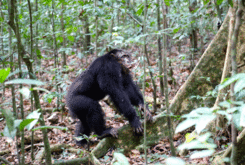Oxytocin enhances social affiliation in chimpanzee groups
In violent intergroup conflicts between chimpanzee groups the hormone oxytocin enhances the social affiliation among members of the same group
The high costs of individuals going to war is perplexing. Individuals are willing to suffer costs in order to benefit their own group, through cooperating and supporting their fellow group members and acting with hostility towards the out-group. Although aggressive, these conflicts are also known to enhance the sense of group belonging and promote social cohesion and affiliation among group members, essential aspects of successful competition with out-groups. Researchers of the Max Planck Institute for Evolutionary Anthropology in Leipzig, Germany, have measured the concentration of the hormone oxytocin in the urine of wild chimpanzees before and during intergroup conflicts and found that their social affiliations enable chimpanzees, too, to stand by each other against rivals.

“We band of brothers; for he to-day that sheds his blood with me shall be my brother.” This quote by Henry V from Shakespeare’s St. Crispin Day Speech shows that humans are willing to sacrifice themselves when fighting in a war against an enemy. The mechanisms involved in maintaining such strong cooperation during wars are not well understood. However, scientists have suggested the involvement of the hormone oxytocin in intergroup conflict among humans. Humans are not the only species to suffer from wars. Chimpanzee societies, for example, also feature coordinated activity within groups during violent intergroup conflicts, in spite of potentially incurring high costs with no immediate benefits to participants.
Oxytocin, an ancient and highly conserved hormone in mammals, is key in instigating mother-infant bonding and maternal defense. Oxytocin has also been associated with various aspects of human and non-human animal’s sociality, such as trust, affiliation, cooperation, and social recognition. In humans, oxytocin has been found to trigger a tendency to defend and cooperate with fellow group members during intergroup social dilemma games. However, this has never been tested in natural between group conflicts, which are highly risky and can lead to injury or even death.
Researchers from the Max Planck Institute for Evolutionary Anthropology in Leipzig, Germany, have investigated the mechanisms underpinning in-group cohesion in times of out-group threat in wild chimpanzees of the Taï National Park, Côte d’Ivoire. Liran Samuni and colleagues measured the animals’ urinary oxytocin hormone levels immediately before and during intergroup conflict events. This was compared with other group cohesive activities that do not involve an out-group threat, such as group hunting. To do this, Samuni and colleagues used a non-invasive method established by co-authors Roman Wittig, Catherine Crockford and Tobias Deschner, for sampling hormone concentrations in urine that can be related to single social interactions or events.
The researchers observed the behavior of two different groups of wild chimpanzees followed by the Taï Chimpanzee Project. They observed various types of behaviors such as: intergroup conflicts, group hunting, multi-partner grooming and periods without any positive social interactions. Throughout the study the researchers followed 10 males and 10 females and collected every possible urine sample for oxytocin analysis. They assessed the impact of the type of event on urinary oxytocin levels, as well as the impact of the subject’s sex, dominance rank, group identity, and proximity to the territory border - as a measure of potential risk.
“We found high urinary oxytocin levels in hunting and intergroup conflict. Both contexts involve group coordination. The chimpanzees’ hormone levels were significantly higher than in contexts without coordinated group activity and were not affected by potential threat or in-group affiliative interactions”, says Liran Samuni, first author of the study. “However, given that intergroup conflict showed significantly higher levels than all other examined events, we concluded that the observed effect is reinforced in the context of in-group out-group perception.”
This result is especially interesting since in humans, in-group out-group perception is a well-documented phenomenon that emerges early in childhood and is thought to be uniquely human. “Chimpanzees are like a band of brothers in the Shakespearean spirit of Henry the Fifth’s St. Crispin day speech”, adds Roman Wittig, senior author of the study. “In the face of a rival group, chimpanzees’ social bonds allow them to stand by each other.” Observing such an effect in wild living animals, points out that in-group favoritism and out-group prejudice may rest on more ancient origins than has been presumed, potentially enhancing cooperation and cohesion among group members when facing outside risk.
LS, CC, RMW, SJ












